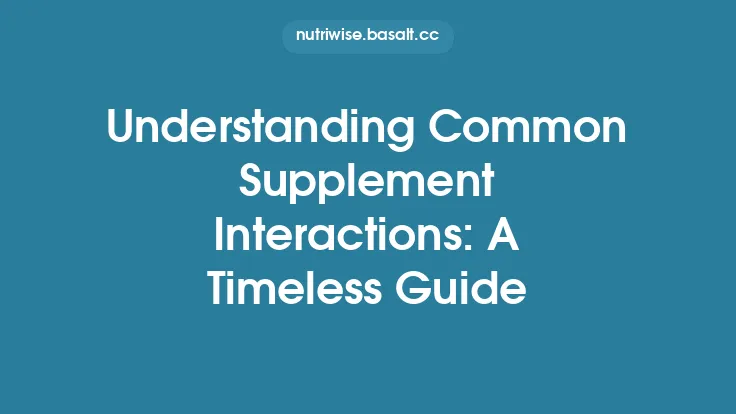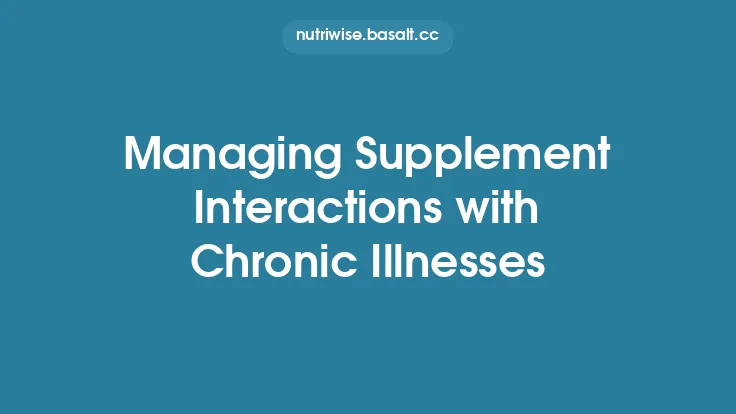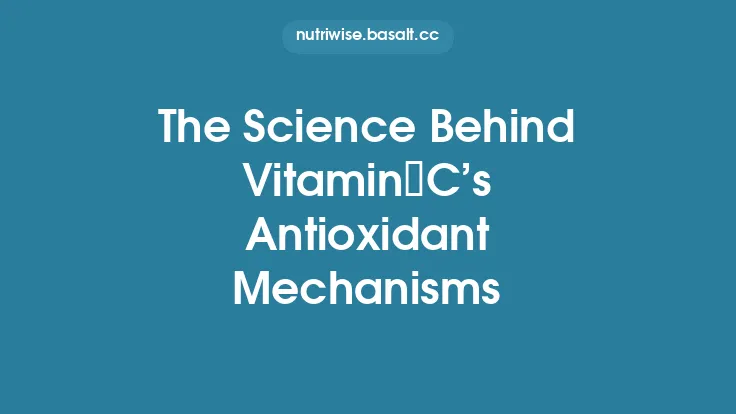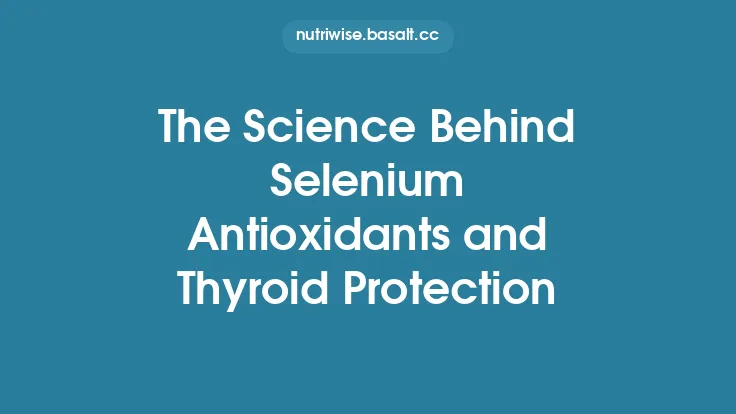Vitamin C (ascorbic acid) rarely acts in isolation within the body’s antioxidant defense system. Instead, it participates in a dynamic network of low‑molecular‑weight antioxidants, enzymatic scavengers, and metal‑binding proteins that together maintain redox homeostasis. Understanding how vitamin C interacts with other antioxidants—both synergistically and antagonistically—provides insight into why a balanced intake of multiple micronutrients is essential for optimal cellular protection.
The Antioxidant Network: A Redox “Web” Rather Than a Linear Pathway
The concept of an antioxidant “network” replaces the outdated view of a single, dominant scavenger. In this web, each component can donate or accept electrons, regenerate other antioxidants, and modulate the activity of redox‑sensitive enzymes. Vitamin C occupies a central hub because of its:
- Rapid electron‑donating capacity (two‑electron reduction of reactive oxygen species, ROS).
- Water solubility, allowing it to operate in cytosol, extracellular fluid, and plasma.
- Ability to regenerate lipid‑soluble antioxidants that reside in membranes and lipoproteins.
When vitamin C is depleted, the entire network becomes less efficient, leading to a cascade of oxidative damage that cannot be fully compensated by any single antioxidant.
Regeneration of Vitamin E (α‑Tocopherol)
Vitamin E is the primary lipid‑soluble antioxidant, protecting polyunsaturated fatty acids (PUFAs) in cellular membranes from peroxidation. Upon neutralizing a lipid radical, vitamin E is oxidized to the tocopheroxyl radical (α‑tocopheroxyl·). This radical is relatively stable but can propagate chain reactions if not reduced back to its active form.
Vitamin C serves as the principal physiological reductant of the tocopheroxyl radical:
\[
\alpha\text{-tocopheroxyl}^\bullet + \text{AscH}^- \rightarrow \alpha\text{-tocopherol} + \text{Asc}^\bullet
\]
- Kinetic advantage: The rate constant for this reaction (≈10⁶ M⁻¹ s⁻¹) is orders of magnitude faster than the spontaneous disproportionation of tocopheroxyl radicals.
- Spatial considerations: Vitamin C, being water‑soluble, accesses the membrane surface via aqueous channels and can shuttle electrons across the lipid–water interface.
- Physiological relevance: In vivo studies demonstrate that vitamin C deficiency leads to a measurable increase in oxidized vitamin E levels, even when dietary vitamin E intake is adequate.
Thus, vitamin C indirectly protects membrane integrity by continuously “recharging” vitamin E.
Interaction with Glutathione (GSH)
Glutathione, a tripeptide (γ‑glutamyl‑cysteinyl‑glycine), is the most abundant intracellular thiol and a key component of the enzymatic antioxidant system (glutathione peroxidase, glutathione reductase). Vitamin C influences glutathione status through several mechanisms:
- Direct reduction of dehydroascorbic acid (DHA): DHA, the oxidized form of vitamin C, can be reduced back to ascorbate by GSH, consuming one molecule of GSH per DHA reduced. This reaction links the redox cycles of the two antioxidants:
\[
\text{DHA} + 2\text{GSH} \rightarrow \text{AscH}^- + \text{GSSG}
\]
- Sparing effect on GSH: By scavenging ROS before they reach the glutathione peroxidase system, vitamin C reduces the demand for GSH oxidation to glutathione disulfide (GSSG). Consequently, the GSH/GSSG ratio—a marker of cellular redox status—remains more favorable.
- Modulation of glutathione‑related enzymes: Vitamin C can up‑regulate the expression of γ‑glutamylcysteine ligase (the rate‑limiting enzyme in GSH synthesis) via activation of the Nrf2 transcription factor, thereby enhancing the cell’s capacity to replenish GSH stores.
Collectively, these interactions illustrate a bidirectional relationship: vitamin C is regenerated by GSH, while vitamin C helps preserve GSH in its reduced form.
Synergy with Carotenoids (β‑Carotene, Lycopene, Lutein)
Carotenoids are a family of lipophilic pigments that quench singlet oxygen (^1O₂) and scavenge peroxyl radicals. Their antioxidant activity is most effective within lipid environments (e.g., cell membranes, lipoproteins). Vitamin C contributes to carotenoid stability in two principal ways:
- Regeneration of oxidized carotenoids: When a carotenoid donates an electron to neutralize a radical, it forms a carotenoid radical cation (Car·⁺). Vitamin C can donate an electron to this cation, restoring the carotenoid’s native structure:
\[
\text{Car}^\bullet^+ + \text{AscH}^- \rightarrow \text{Car} + \text{Asc}^\bullet
\]
- Prevention of oxidative degradation: By reducing ROS in the aqueous phase, vitamin C limits the diffusion of radicals into the lipid phase where carotenoids reside, thereby decreasing the frequency of carotenoid oxidation.
Epidemiological data consistently show that diets rich in both vitamin C and carotenoids confer greater protection against oxidative biomarkers than either nutrient alone, supporting the mechanistic synergy described above.
Metal Chelation and the Fenton Reaction
Transition metals such as iron (Fe) and copper (Cu) catalyze the conversion of hydrogen peroxide (H₂O₂) into highly reactive hydroxyl radicals (·OH) via the Fenton and Haber‑Weiss reactions:
\[
\text{Fe}^{2+} + \text{H}_2\text{O}_2 \rightarrow \text{Fe}^{3+} + \cdot\text{OH} + \text{OH}^-
\]
Vitamin C can both promote and inhibit these reactions, depending on the cellular context:
| Situation | Role of Vitamin C | Outcome |
|---|---|---|
| Free, unbound Fe²⁺ | Reduces Fe³⁺ to Fe²⁺, potentially enhancing Fenton chemistry | ↑·OH production (pro‑oxidant) |
| Bound metal complexes (e.g., ferritin, transferrin) | Chelates Fe³⁺, stabilizing it and preventing reduction to Fe²⁺ | ↓·OH generation (antioxidant) |
| Presence of strong chelators (e.g., citrate, EDTA) | Forms stable Fe‑ascorbate complexes that are less reactive | ↓Fenton activity |
Thus, vitamin C’s net effect on metal‑catalyzed oxidation hinges on the availability of binding partners that sequester transition metals. In physiological conditions, the majority of iron and copper are protein‑bound, allowing vitamin C to act predominantly as a protective agent by limiting free metal‑catalyzed radical formation.
Interaction with Enzymatic Antioxidants
Beyond low‑molecular‑weight antioxidants, vitamin C influences the activity of several key antioxidant enzymes:
- Superoxide Dismutase (SOD) – Vitamin C does not directly alter SOD’s catalytic conversion of superoxide (O₂·⁻) to H₂O₂, but by reducing the steady‑state concentration of O₂·⁻, it indirectly lessens the burden on SOD.
- Catalase and Peroxidases – By scavenging H₂O₂ before it accumulates, vitamin C reduces the substrate load for catalase and glutathione peroxidase, preserving these enzymes for periods of heightened oxidative stress.
- NAD(P)H‑quinone oxidoreductase 1 (NQO1) – Vitamin C can up‑regulate NQO1 expression via the Nrf2 pathway, enhancing the reduction of quinones to less reactive hydroquinones, thereby preventing redox cycling.
These interactions illustrate that vitamin C functions both as a frontline scavenger and as a regulator of the enzymatic arm of the antioxidant system.
The Role of Vitamin C in Lipoprotein Oxidation
Low‑density lipoprotein (LDL) particles are prone to oxidative modification, a key step in atherogenesis. Vitamin C contributes to the protection of LDL through:
- Aqueous phase scavenging: By neutralizing aqueous ROS before they can penetrate the LDL surface.
- Regeneration of α‑tocopherol within LDL: As described earlier, vitamin C restores oxidized tocopherol, preserving the particle’s intrinsic antioxidant capacity.
- Interaction with plasma proteins: Vitamin C can reduce oxidized albumin and other plasma proteins that otherwise act as pro‑oxidant catalysts for LDL oxidation.
Clinical studies that measured oxidized LDL (oxLDL) levels in subjects with adequate versus deficient plasma vitamin C consistently report lower oxLDL concentrations in the former group, underscoring the practical relevance of this interaction.
Dietary Implications: Co‑Consumption Strategies
Because vitamin C’s antioxidant efficacy is amplified when paired with complementary nutrients, dietary patterns that provide a balanced mix of water‑soluble and lipid‑soluble antioxidants are especially beneficial. Practical guidelines include:
- Combine citrus fruits or berries (high in vitamin C) with nuts, seeds, or oily fish (rich in vitamin E and omega‑3 fatty acids).
- Pair carotenoid‑dense vegetables (e.g., carrots, tomatoes, leafy greens) with a modest source of vitamin C to facilitate in‑situ regeneration of oxidized carotenoids during digestion and absorption.
- Include sources of bioavailable minerals (e.g., legumes, whole grains) that supply iron and copper bound to proteins, ensuring that vitamin C’s metal‑chelating actions remain protective rather than pro‑oxidant.
These synergistic food combinations support the antioxidant network without the need for high‑dose supplementation.
Potential Pitfalls of Isolated High‑Dose Vitamin C
While the focus of this article is on interaction, it is worth noting that excessive isolated vitamin C intake can perturb the antioxidant balance:
- Pro‑oxidant activity in the presence of free transition metals – Very high plasma concentrations of ascorbate may reduce Fe³⁺/Cu²⁺, fueling Fenton chemistry if metal‑binding capacity is overwhelmed.
- Impaired regeneration of other antioxidants – Overabundant ascorbate can saturate the recycling pathways, leading to accumulation of dehydroascorbic acid, which may be taken up by cells via GLUT transporters and, if not promptly reduced, act as a mild oxidant.
Thus, maintaining vitamin C within physiologically normal ranges, preferably through whole‑food sources, optimizes its collaborative role within the antioxidant network.
Future Directions in Research
The intricate crosstalk between vitamin C and other antioxidants continues to be an active field of investigation. Emerging areas include:
- Redox proteomics – Mapping the specific protein thiol modifications that are prevented or reversed by vitamin C‑mediated regeneration of GSH and vitamin E.
- Nanocarrier delivery systems – Designing lipid‑based nanoparticles that co‑encapsulate vitamin C and lipophilic antioxidants, mimicking the natural co‑localization in plasma and membranes.
- Systems biology modeling – Using computational models to predict how fluctuations in dietary vitamin C affect the global redox state, accounting for feedback loops involving Nrf2, metal homeostasis, and enzymatic antioxidant capacity.
These approaches aim to translate the mechanistic understanding of antioxidant interactions into targeted nutritional strategies and therapeutic interventions.
Take‑Home Messages
- Vitamin C is a central hub in the body’s antioxidant network, capable of directly scavenging ROS, regenerating lipid‑soluble antioxidants (vitamin E, carotenoids), and interacting with glutathione.
- Its metal‑chelating properties can be either protective or pro‑oxidant, depending on the availability of protein‑bound metals.
- The synergistic relationship between vitamin C and other antioxidants enhances overall redox resilience more than any single nutrient could achieve alone.
- Whole‑food dietary patterns that provide a balanced mix of water‑soluble and lipid‑soluble antioxidants are the most reliable way to sustain this network.
- While high‑dose isolated vitamin C is generally safe, excessive amounts may disrupt the delicate balance of the antioxidant system, especially in the presence of free transition metals.
By appreciating vitamin C’s collaborative role, nutrition professionals and health‑conscious individuals can better design diets and interventions that harness the full protective power of the body’s antioxidant web.





